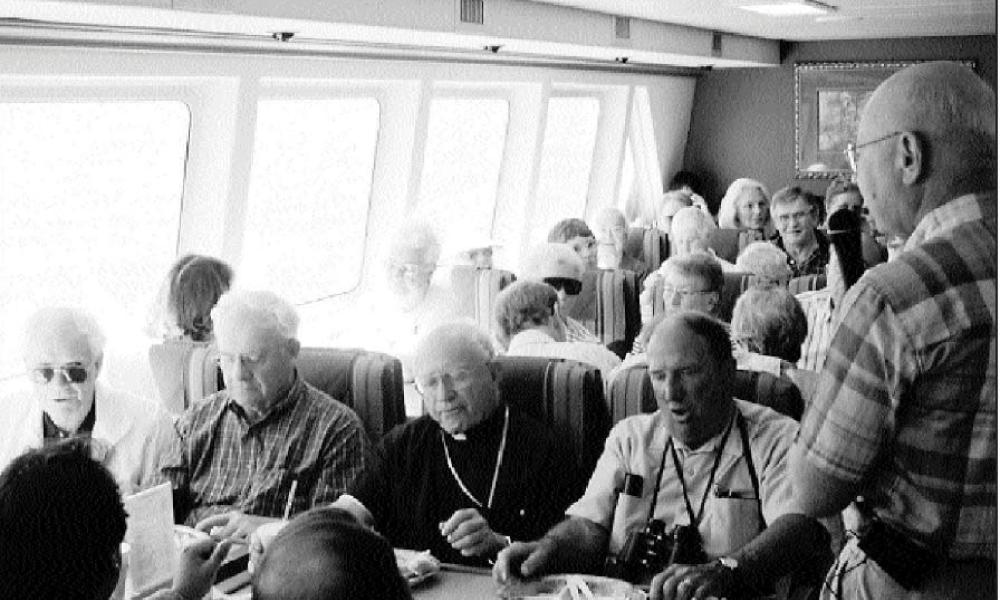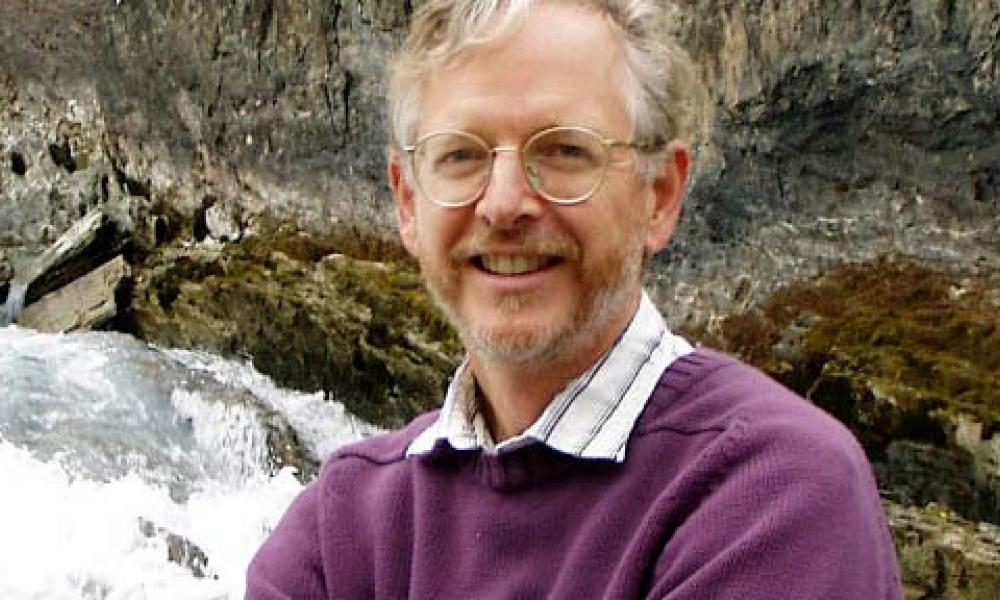
A Living Document Speaks to Living Waters
Celilo Falls was the largest waterfall on the Columbia River until the mid-1950s when the falls were drowned beneath the reservoir behind The Dalles Dam. Celilo Falls was at times the largest waterfall by volume in North America, depending upon peak summer flow rates, exceeding Niagara Falls — and always exceeding by more than double the current flow rate of Niagara Falls. The ancient villages near Celilo were the oldest continuously inhabited place in North America until they disappeared beneath the waters behind the new dam. (Courtesy Columbia River National Scenic Area)
The Columbia River Watershed: Caring for Creation and the Common Good,” an international pastoral letter by the Catholic bishops of the Northwest, celebrates its 20th anniversary
In 2014, an emergency room physician who is also an environmental activist traveled from Washington state to Italy with an extraordinary Catholic document he wanted to share with Jesuit Father Michael Czerny, now Cardinal Czerny. Dr. John Osborn knew the Canadian priest was working with Pope Francis on an encyclical that would clarify the church’s teaching on climate change, the poor and the environment.
The encyclical, of course, was “Laudato Si’.”
The document Osborn brought to Rome was “The Columbia River Watershed: Caring for Creation and the Common Good,” a pastoral letter issued by the 12 Catholic bishops of the Pacific Northwest in 2001. The bishops wrote that they hoped “we might work together to develop and implement an integrated spiritual, social and ecological vision for our watershed home, a vision that promotes justice for people and stewardship of creation.”
“I gave Father Czerny a copy and we talked for more than an hour,” said Osborn. “I don’t know if it was incorporated directly into “Laudato Si,’” but I like to think that the spirit of the Columbia River watershed pastoral letter helped form its foundation.”
A “watershed” may not sound like much, but in fact the Columbia River watershed is bigger than France, nearly 259,000 square miles. It reaches into seven states and British Columbia in Canada, and it drains more water into the Pacific Ocean than any other river in North or South America.
The 1,243-mile-long river, with its tributaries, was once blessed with the largest salmon runs on earth. At least 10 to 16 million salmon annually made their way to spawn up its wide, mighty reaches, roaring narrows and rippling stream beds. Some of the fish reached 100 pounds; salmon weighing more than 50 pounds were common.
“We exchanged the richest salmon river on earth for one of the world’s most intensely integrated hydropower systems,” said Osborn. “Many benefited, but it came at a wrenching cost for some — particularly Indigenous peoples.”
The letter acknowledges that reality. It also considers the people (more than 8 million as of 2016) who live within the watershed, people who depend on hydroelectricity and on the flood control the dams provide.
Beginnings
The pastoral letter’s beginnings were at Mount Angel.
In the 1990s, a grant from the ecumenical National Religious Partnership for the Environment paid for a retreat on the hilltop, led by Benedictine Father Hugh Feiss.
“It was a real retreat,” said Walter Grazer, former manager of the Environmental Justice Program of the U.S. Conference of Catholic Bishops. “We didn’t delve into issues, we prayed together.”
Father Feiss directed the group of Catholic social justice ministers in gratitude for God’s creation.
In the last couple hours of their time together, regional groups met to consider what project they might take on together.
Those from Pacific Northwest dioceses began thinking about water.
The next meeting took place the following year at St. John’s University in Collegeville, Minnesota. By then those Northwestern attendees knew they wanted to focus on the mighty — and mightily dammed and polluted — Columbia River. They put together a proposal to develop a letter, and their plan intrigued Bishop William Skylstad of Spokane.
“He immediately appreciated the seed of the idea,” said Frank Fromherz, then head of the Archdiocese of Portland’s Office of Life, Justice and Peace. “He was close to the ground, close to the water and the earth.”
Bishop Skylstad had grown up along the Methow River, a tributary to the Columbia, in central Washington. “The river meant a lot to us,” he said.
Bishop Skylstad notes that throughout Scripture there are references to how flowing water —living water — renews life and connects creation. He saw God’s hand at work in the Columbia River as well.
“The Columbia River runs through mountainous areas to dry highlands and lush lowlands,” he said. “It also connects a diversity of communities along the river — including Portland and so many small towns where irrigation is paramount.”
The church as convener
The letter’s steering committee convened thousands of Northwesterners from all walks of life and beliefs over two years as they held listening sessions. Eight sessions, held from November 1997 to March 1999, one in each of the dioceses represented, provided a forum for people to share their thoughts about the river. After a draft was released, the committee traveled to another seven venues, between August and November 1999, to hear what people thought about what had been written.
“The process was critical,” said Fromherz. “We marshaled a lot of resources and energy.”
They traveled to Hanford, Washington, where they heard that millions of gallons of radioactive waste had been stored in the 1940s in tanks meant to last 20 years. The tanks were leaking into groundwater and threatened to contaminate the river.
They heard from environmentalists in Portland and fishermen at the Columbia Maritime Museum in Astoria. They listened to people whose relationship with the river was framed in what Fromherz calls a “Woody Guthrie economic New Deal worldview,” where the river played a deeply significant economic role in their lives, whether that is because they worked in the barge industry or because their jobs were fueled by cheap energy through hydropower. The committee heard from Indigenous people who spoke to the need to dismantle dams and restore the free flow of the river for the sake of the salmon and river’s health, and the people’s spiritual health.
The gold mining industry, which leaves behind arsenic-poisoned reaches of the river, sent representatives who pointed out that the church uses gold chalices. Other speakers said the church shouldn’t use gold sourced through the leaching process.
“I looked at it as the church as convener,” said Grazer. “That’s a fabulous role for the church. They were pulling together Native Americans, loggers, city folk, people who were concerned with fishing and hunting. And the church was listening — not saying, ‘Here’s the answer.’ You had all kinds of people who did not want to be in the room together. But the church provided a space for people to speak in an atmosphere of respect for one another. It serves as a great model.”
The sessions were sometimes tense. A science professor from the Salish Kootenai College in Montana, interviewed by the New York Times about the letter, described a meeting during which a logger harangued Bishop Skylstad “at length.”
Bishop Skylstad, who chaired the steering committee, went to all the meetings.
The genial bishop remembers that for the most part even hot-button issues — like breaching the dams — were addressed civilly, despite some speakers being fearful about the future. While “sustainability” was a dirty word for some participants, Bishop Skylstad never felt any controversy over whether it was appropriate to care about the river. The letter was never about lowering the boom on anyone, he said. “But we need to take responsibility.”
Msgr. Charles Lienert, who was a consultant for the letter, was impressed by the respectful dialogue, something he thinks the church is still especially equipped to bring about. The key, he said, is to truly listen to another person’s story, their hopes and fears, what brings them joy. “That is powerful,” he said.
Mary Jo Tully, former chancellor of the Archdiocese of Portland, was delighted by the letter’s ability to connect, which also included connecting different religious communities. “I didn’t expect it to be an ecumenical document,” she said. “But it was. The sacramental notion of creation is something all these faith communities held. The document became a wonderful tool for dialogue because we could all reflect upon it together.”
Catholic theology and the environment
In the mid-1990s, at the time of the letter’s genesis, there was not much to tie Scripture passages on creation to crises of environmental destruction.
The beginnings were there. The bishops of Appalachia had released a pastoral letter, “This Land is Home to Me,” in 1975 about the devastation that mountaintop removal coal mining was leaving behind and the effect on the poor. In 1990 St. John Paul spoke to creation care in his World Day of Peace statement, “The Ecological Crisis: A Common Responsibility.” The U.S. bishops released “Renewing the Earth: An Invitation to Reflection and Action in Light of Catholic Social Teaching” in 1991.
The pope and bishops were arguing that God loves his creation, wanted humanity to protect it and that the issue was intricately bound with the church’s option for the poor.
Grazer disagrees with American historian Lynn White’s influential 1966 paper that blamed the environmental crisis not only on the technological ability to destroy the planet, but more profoundly on the Western worldview. The Judeo-Christian worldview, argued White, sees humanity as separate, completely divorced from nature and the world — a recipe for destruction.
“But that rapaciousness doesn’t square with Scripture,” said Grazer. “Bringing out what is really in the Bible corrects those misperceptions that give people permission to be rapacious toward nature.”
Grazer believes the letter’s insights are mirrored in “Laudato Sí’.” “I see a consistency of themes,” he said. “It’s biblically based and flows out of Catholic social teaching.”
A tool for reflection
When Archbishop John Vlazny of Portland first heard about the project, he was hesitant. Newly arrived in the archdiocese, his calendar was full, getting to know the parishes and people he was charged to shepherd. He signed on anyway. “We became involved, and I felt very good about it,” he said. “At the heart of it was that God is the creator and he entrusts the earth to human care.”
Archbishop Vlazny remembers the listening sessions. “What if we really did share the river equitably?” facilitators asked. “What about swimming and farming and fishing?”
“We were trying to make it practical,” he said. That meant looking at the river for its economic value but also including its intrinsic value in the equation.
“We weren’t trying to guilt anyone, but just to make them think,” Archbishop Vlazny said. “We all need to realize the river is a gift.”
The letter, Archbishop Vlazny said, was meant to be a tool for reflection, not a handbook for action. He said it provided conversion opportunities for him personally, admitting that his generation hadn’t paid enough attention to caring for the environment. “God still gives me things to pray about,” he said.
Trudie Atkinson, a member of St. Thomas More Parish in Eugene, reread the letter recently. Atkinson said she has begun thinking about what she can do to protect the watershed — like picking up trash when she walks. “That action reminds me what a wonderful gift the water is, and to thank God for it,” she said.
Atkinson, who studied “Laudato Si’” at her parish, is grateful that the letter is, like the encyclical, an accepted part of church teaching, emphasizing the link between protecting vulnerable populations and the protection of the environment. “Care for the earth means caring for the very least,” she said. “This is basic Catholic teaching.”
One river, ethics matter
Osborn still remembers the visceral relief he felt upon reading the letter 20 years ago. He’d been feeling exhausted, and it gave him hope. “We’d been through the forest wars over spotted owls and mining wastes, and fundamentally these are ethical issues,” he said. “The letter makes that so incredibly clear. It’s a powerful tool in engaging the region in a conversation about the future of the Columbia River.”
As part of an alliance of environmental advocates, Osborn has been using the letter as a framework to structure annual “One River, Ethics Matter” conferences since 2014. They discuss the Columbia River Treaty, now being renegotiated, between Canada and the United States.
“The letter provides a foundation for talking about principles like stewardship and justice,” he said. “When you’re looking at conflicts and trade-offs, you’re looking to share the benefits and burdens.”
“The pastoral letter is a very important statement that ethics need to play a primary role in how decisions are made by society for today and tomorrow,” agreed Phil Harju, Cowlitz tribal chairman.
Under the current 1964 treaty, the dams are managed solely for flood control and hydropower.
Osborn’s alliance would like to see environmental health and salmon sustainability become a third driving consideration. They also call for tribal nations to be at the table and part of renegotiations. Canada has agreed to that, the United States has not.
Canadian and U.S. negotiators are also making changes necessitated because of climate change.
Harju said the Cowlitz people have experienced numerous atrocities as European immigrants moved to the tribe’s lands, including “subrogation to other sovereign governments, pandemics more deadly than COVID, theft of our lands and natural resources, destruction of our first foods, and attempts to eliminate our people and culture.”
Harju said by email that it wasn’t too late to remedy the environmental damage that has come in the past century. “The future needs to be different,” he wrote.
More than 500 people registered for the latest “One River, Ethics Matter” conference, which took place in December in Vancouver, Washington. Many of those attendees were federal employees of Canada and the United States, and they are being evangelized by the letter, because all conferences are organized using its structure.
“One of the values of the letter is first encouraging people to come together to listen,” Osborn said.
Harju said it’s vital for the general non-Indigenous community to understand what has happened to the Cowlitz people, “so that the future can be brighter for us all.”
The river of our vision
Tully said the letter exceeded her expectations in both its reach and its contents. “It’s not a dogmatic document,” she said.
“I’ve been reflecting on how much it anticipated “Laudato Si’,” said Msgr. Lienert.
“I’m proud of the work,” said Bishop Skylstad. “It’s a fine example of collaboration, both within the Catholic community and in the ecumenical community as well.”
Bishop Skylstad said he was glad the bishops decided against including policy suggestions in the document. That would have dated it and limited its import, he thinks.
It should be noted that while most Catholics embraced the pastoral letter, others derided it. “Many who work in resource extraction industries in the Northwest feel the letter has a liberal, anti-business slant,” reported the New York Times in 2000. John Reid, a consultant to the project, told that reporter that while 75% of the feedback had been positive, with comments like “I am proud to be a Catholic,” the remaining 25% was critical, with some even saying the bishops “had been co-opted by eco-terrorists.”
Now, 20 years later, in times that are still marked by division, Osborn believes the letter will continue to be a resource that will help communities approach questions about the watershed ethically. “We’re at the end of the water frontier,” he said. “We’ve over-appropriated the waters of this region, we’ve issued too many water rights, and there isn’t enough water to fill all the demands. We’re going to have to do things differently.”
Osborn sees hard choices ahead, because of these past decisions. “They’re economic and political choices, but they’re also ethical choices,” he said.
He believes the letter can help.
“When I saw the pastoral letter 20 years ago, I thought, ‘Wow, this is such an important document,’” Osborn said. “Nothing has changed my opinion on that. I think it has increased in importance.”
Reprinted with permission of the Catholic Sentinel in the Archdiocese of Portland. Originally published February 8, 2021.
Learn more
Read the pastoral letter
A PDF of the original booklet issued by the bishops is available at https://www.wacatholics.org/stay-informed/the-columbia-river-watershed-caring-for-creation-and-the-common-good. Click on "pastoral letter booklet" pdf in English, Spanish and French.
Reflection guide
The six-page “Columbia River Watershed: Caring for Creation and the Common Good” reflection guide is at https://www.yakimadiocese.org/attachments/article/964/CR%20Pastoral%20Discussion%20Guide-Eng.pdf.
Take action on the Columbia River Treaty
Dr. John Osborn has created a “Declaration on Ethics and Modernizing the Columbia River Treaty” based on the template of the Columbia River Pastoral Letter. Print it out and sign it, send it on to the address at the end of the declaration: go.sentinel.org/39p5vDs. For reference, the list of those already having signed the Declaration on Ethics and Modernizing the Columbia River Treaty includes a number of faith leaders, including Archbishop Alexander Sample of Portland, Bishop John Corriveau of Nelson, Bishop Blase Cupich of Spokane, Archbishop Peter Sartain of Seattle and Bishop Joseph Tyson of Yakima. The list is here: celp.org/declaration-signers.
Information on the annual “One River Ethics Matter” conferences can be found at the Center for Environmental Law and Policy’s website: celp.org.









